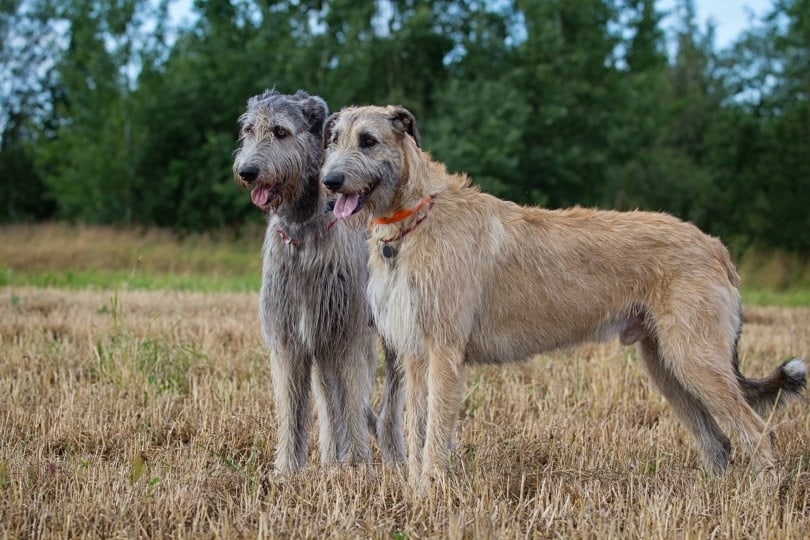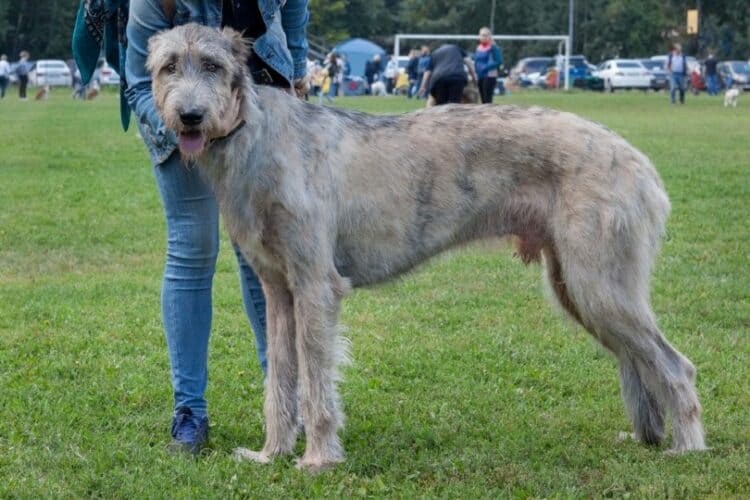The Irish wolfhounds are a unique breed. The AKC recognizes it as the tallest breed in the world, averaging 105–120 pounds as adults, and they have a distinctive appearance, with a wiry coat in various shades of grey. Because of their stately stature and kind nature, many potential pet owners turn to the Irish wolfhound.
If you suffer from dog allergies, you may be worried that a dog as big as “the Big Dog of Ireland” may cause even bigger allergy symptoms. Unless, of course, they are hypoallergenic.
So, are Irish wolfhounds hypoallergenic? No, they aren’t. Unfortunately, no dog is 100% hypoallergenic or guaranteed not to cause allergy symptoms.
We will examine why that is and why the Irish wolfhound may still be an excellent pet for you if you have allergies below. Keep reading!
Why Do All Dogs Cause Allergies?
You are most likely reacting to the proteins in their skin if you experience a runny nose, congestion, and itchy, watery eyes when around a dog. Over time, all animals will shed dead skin cells, even humans. Respiratory dog allergies can be mild or severe and may affect other conditions like asthma.
You may also be allergic to the dog’s fur, but not in the way you think. Pet hair doesn’t contain proteins, but the dog’s saliva sticks to its fur as your dog grooms itself. When the dog goes outside, they may roll around in the grass or pick up other outdoor allergens and bring them inside.
Do Irish Wolfhounds Shed a Lot?
Irish wolfhounds have a double coat, so they do shed. However, they don’t shed nearly as much as some breeds with thicker double coats, like the Akita and the Shetland sheepdog. They shed moderately throughout the year without an increase during the spring and fall like many others with similar double coats. Those with dog allergies that also have seasonal allergies to pollen won’t have to worry about increased allergies due to their pet’s shedding when living with an Irish wolfhound.

Tips for Living with Dog Allergies
Thankfully, there are steps you can take to make living with your Irish wolfhound much easier if you suffer from dog allergies.
- Regular Grooming: Taking your dog to the groomers will help reduce danger and loose fur in your home.
- Close-Off Bedrooms: Keeping the dog out of the bedrooms will ensure you have a mostly dander-free zone.
- Keep Off Furniture: Furniture and other upholstery can hold onto pet dander, even with regular cleaning. If you can’t keep pets off the furniture, try using a high-quality furniture cover.
- Wash Your Hands: When we touch our face after touching our pet, we bring dander and allergens from their fur right to our face, where they are most likely to cause symptoms.
- Use Static Charge Cleaners: Using a static cling cloth or another device that traps dirt will be more effective at picking up dander so you can remove it from your home.
- Vacuum and Dust Regularly: Homes with pets should be vacuumed once or twice a week. Look for a vacuum with a HEPA filter for more effective cleaning.
- Have Some Else Do the Chores: Household chores are necessary but have the potential to kick up some dander in the short term. Have someone else clean the house to minimize your symptoms.
- Use HEPA Filters: A high-efficiency particulate air filter, or HEPA filter, is much more effective at removing small particles from the air in your home, including pet dander.
- Replace Your Flooring: Replacing the flooring in your home with a hard surface like tile, linoleum, or wood can make cleaning up after your pet much more manageable.
Final Thoughts
If you have any concerns before adopting a pet or experiencing allergies once you’ve welcomed a new pet home, be sure to discuss your concerns with their vet or doctor. In addition to the steps above, you may be able to treat more severe allergies with medication. Don’t let dog allergy symptoms prevent you from enjoying the many benefits of being a pet parent.
Featured Image Credit: Shutterstock














